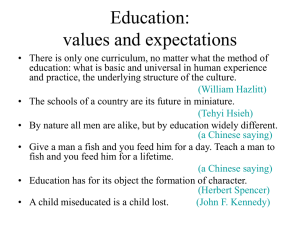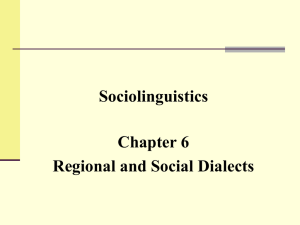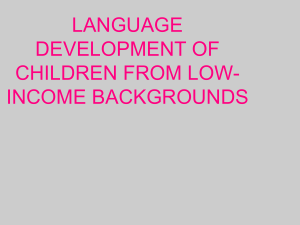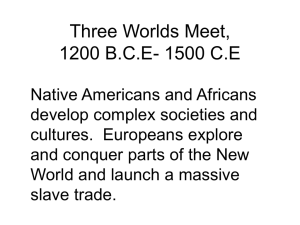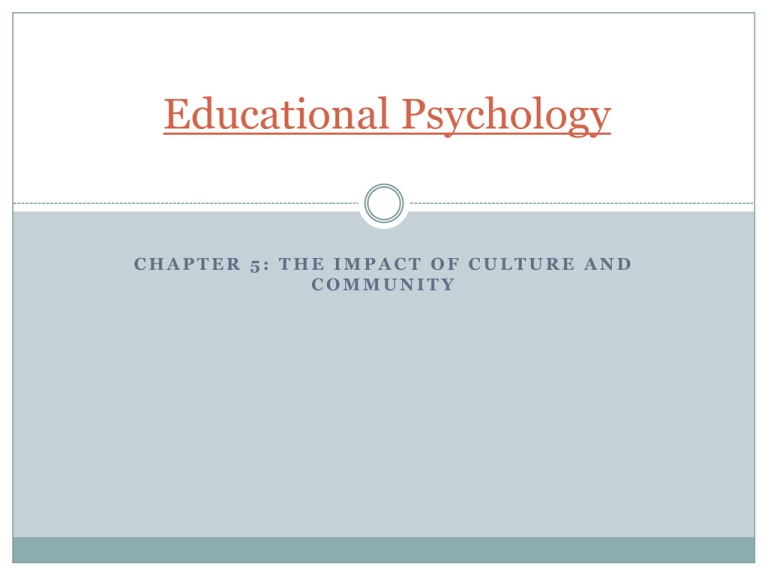
Educational Psychology
CHAPTER 5: THE IMPACT OF CULTURE AND
COMMUNITY
Today’s Multicultural Classroom
Individuals, Groups, and Society
From a cultural deficit model (assuming other cultures did not prepare
children) to a multicultural education model (which expands curricula
and activities to include other cultures) our system has progressed.
American Cultural Diversity
Culture and Group Membership
The group creates the culture and communicates the culture to the
members. Each of us is a member of many groups. E.g. I am a white,
Appalachian, college-educated, southern, American, Episcopalian,
working-class, male.
Cautions in Interpreting Cultural Differences
Membership in a certain group does not dictate behavior but makes
certain types of behavior more probable. Stereotypes, assumptions,
and generalizations are dangerous and destructive.
Social Class Difference
Socioeconomic Status
Socioeconomic Status (SES) is a sociological term to describe
variations in wealth, power, privilege, and prestige
Who are the Poor?
In 1994, more than one in four American children lived
in poverty. That is comparable to modern rates.
Most of these children are white, and living in rural areas.
While the numbers of African American and Hispanic children living
in poverty is smaller, the percentages are much higher.
SES and Achievement
There are correlations of SES and achievement, however,
family involvement and attitudes have a great bearing on
this, too.
Social Class Difference, cont’d.
SES and Achievement
Low Expectations—Low Self-Esteem
If a teacher assumes a student is less bright by the way they speak or dress, the
teacher may not call on them, or challenge them, etc.
Learned Helplessness
Low-SES students may come to believe that doing well in school is hopeless.
Children, especially low-SES children of color can come to believe it is impossible
to advance in the mainstream.
Resistance Cultures
Some culture can define success in school as betrayal or “selling out.”
Tracking
Low-SES students can be taught differently, which is a very predictable way of
making low-achievement for any children.
Childrearing Styles (E.g. puzzle pieces)
Differences in raising children is the oldest explanation (and perhaps most tired)
for why low-SES students struggle. However some class differences are clear in
language and other development. Beware, this can easily turn to victim-blaming.
Ethnic and Racial Differences
Ethnicity Defined – Groups in terms of common nationality, culture,
or language.
The Changing Demographics
There is currently a very large immigrant population boom in the U.S. By 2020,
half of the population of the country will be of ethnicities other than white
Americans.
Cultural Differences
Culture has vast differences. Few of which are visible.
Cultural Conflicts
A study of interaction of guidance counselors with students of same or different
cultures found that non-verbal communication can be destructive in interaction
and relationship building.
Cultural Compatibility
Some cultures have traits or foci that enhance the children’s success in American
school systems.
Working with Families and Communities
Find ways to learn about the working families and the community’s culture.
Ethnic and Racial Differences , cont’d.
Ethnic and Racial Differences in School Achievement
The Legacy of Discrimination
American school systems have a terrible track record for multicultural
education. The book sites the story of Linda Brown and others who filed suit in
Brown v. Board of Education
Continuing Prejudice
Several studies of late continue to prove that though great strides have been
made, our dominant culture is one of prejudice and generalization.
The Development of Prejudice
We are not in agreement how prejudice develops, but we know that it can be
positive or negative and is difficult to combat. It is a part of schema, or
organizing of information by the brain.
Continuing Discrimination
While prejudice is an attitude, discrimination is a behavior. Black and
Hispanic students are tracked in less engaging math and science classes
through school, thus education becomes a discriminatory institution in the
U.S.
Women and Men: Differences in the Classroom
Gender-Role Identity
Typically, men and women have different styles of personalities. However, in school,
often certain ideas on gender are reinforced.
Gender-Role Stereotyping in the Preschool Years
Early childhood is where we often begin with different treatment of boys and
girls. Boys are pushed away sooner, and girls are protected longer.
Gender Bias in the Curriculum
Children continue to learn about what it means to be male or female. Textbooks
are a major source of gender bias in school. Often men are depicted in
illustrations, and women are left out, or are only shown at home , behaving
passively, or expressing fear or incompetence. Males, the opposite.
Sex Discrimination in Classrooms
Lots of research on the issue has shown that males are more vocal, and
encouraged to be so in the class than females. Teachers ask more questions of
males and give more feedback. By the time students reach college, males are
twice as likely to initiate comments in class as females.
Women and Men: Differences in the Classroom,
cont’d.
Sex Differences in Mental Abilities
Most studies find few differences in boys and girls motor and mental
development before preschool. School years are where the gaps are
made.
Sex and Mathematics
There has been a shrinking gap between males and females in math
achievement, overall. However, SES, race, and ethnicity have large
variances in achievement in math.
Additionally, males, specifically white males account for 80% of
math and science professionals.
Eliminating Gender Bias
Studies show that there are methods to help eliminate gender bias,
such as balancing cooperative and competitive activities in math
instruction. Watching for unintended biases in your classroom, and
closely surveying the textbooks are other good methods.
Language Differences in the Classroom
Dialects – Language variation spoken by a culture.
Dialects and Language Skills
Pronunciation can lead to difficulties with language and
understanding. In “black English” and southern dialects often
do not pronounce the end of words. It is not wrong, it is how
students speak.
Dialects and Teaching
The best approach to teaching with dialects seems to be
understanding and accepting children’s dialects while teaching
the standard form of English.
Language Differences in the Classroom, cont’d.
Bilingualism
What Does Bilingualism Mean?
Literally it means speaking two languages, however it also means balancing
cultures, behaviors, expectations, and identities.
Becoming Bilingual
Children learn two languages best in early childhood, and can be functionally
bilingual by age 4. It requires continued study for a student to maintain both
face-to-face and academic bilingualism.
Bilingual Education
Should non-English speaking children be taught in other languages?
Performance of non-English students for English-centered education is poor, but
debate continues. Neither the book nor I will assert an answer here.
Research on Bilingual Programs
Research indicates that bilingual programs are successful, however political
debate makes it difficult to assert a standard for it. What is appropriate for each
child should be the driving force for each teacher.
Creating Culturally Compatible Classrooms
Social Organization
Social organization is one way of organizing classrooms to suit learners of a culture, which mirrors the needs, values, and
uses of the culture. E.g. Hawaiian children do better in small cooperative groups, as Hawaiian society depends heavily on
collaboration and cooperation.
Learning Styles
Hispanic Americans
Some Native Americans appear to have a more global and visual leering style. E.g. Navajo students prefer to hear
story entirely before having questions.
Asian Americans
Summary of research suggest that learning styles of African Americans is inconsistent with teaching of most schools
including visual/global rather than verbal analytic approach.
Native Americans
Early research suggests that Mexican Americans prefer holistic, concrete, social approaches to learning. Other
research suggests family and group loyalty is important.
African Americans
Learning styles are another dimension of classroom adaptation.
There has been little research on Asian Americans because they have been stereotyped as a “successful minority” in
the educational system.
Criticisms of Learning-Styles Research
Learning Styles Research is dangerous. It can easily lead to assumptions and generalizations. Remember that no
individual’s behavior or preference for learning may not be what is considered optimal for his or her race, ethnicity,
or class. These are only statistical analyses.
Creating Culturally Compatible Classrooms,
cont’d.
Sociolinguistics – the study of courtesies and
conventions of conversation across cultures.
Participation Structures
Students must clearly understand and be able to participate in
the communication and education of the group.
Sources of Misunderstandings
School structures are more similar to some students than
others. This means that some students are more at ease in
school than others, and are more likely to understand the
“unwritten rules.”
Summary
Bringing It All Together: Teaching Every Student
Know Your Students
Class, race, gender, ethnicity, orientation, language, etc, are
things you need to know and understand about your students.
Respect Your Students
Empathizing and valuing the differences in diversity, and
understanding that your students have lived a different life
than you, and bring valid experiences to the class.
Teach Your Students
Every child has gifts, talents and potiental. Use it to own your
students’ success.





